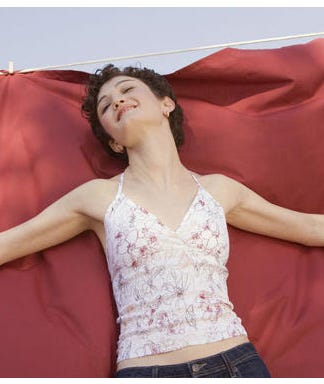How to Make a Contact Sheet on Word

© Comstock
Comfortable and attractive sheets are more affordable than ever, with manufacturers offering an endless selection of colors, patterns and trims for every budget. But who would guess that something as basic as a new set of sheets could not only freshen the look of your bedroom but also help you sleep better? If you're considering buying new bedsheets, here is what to look for.
Fabrics
Cotton is by far the most popular fabric for sheets. Because of their long fibers (also known as staples), the highest quality cotton varieties are Sea Island cotton, grown off the east coast of the United States; Egyptian cotton, grown in Egypt; and Pima cotton, grown in the U.S. (named after the Pima Indians).
Check labels carefully: Even if the products are made with just a small percentage of these high-quality fibers, they can be identified as Egyptian, Pima or Sea Island cotton. Look for a high percentage; Supima Cotton is a trademark that indicates the fibers are 100 percent Pima cotton.
Weaves include percale, a closely woven plain weave resulting in a silklike feel; sateen, which has more yarn on the surface and a softer, more lustrous hand; flannel, a brushed cotton with a napped finish and a cozy, fuzzy feel; and jersey, a flat cotton knit often used for T-shirts. In addition, there are luxury f abrics such as silk, which is extra-fine with a brilliant sheen; satin, which is has a lustrous surface; and linen, which is very soft but has a more visible structure.
Bed linens in fabrics and blends that are environmentally friendly are gaining popularity, and are becoming easier to find. Certified organic cotton has the same properties as conventional cotton, but is grown without the use of pesticides, insecticides or chemical fertilizers. Bamboo is a soft, breathable fiber made from renewable bamboo grass. Bamboo sheets are naturally resistant to bacteria and are able to wick away moisture. Beech sheets comes from beech trees grown on sustainable farms specifically for their fiber, which is often marketed under brand names such as Tencel. Both bamboo and beech can be blended with cotton for increased durability.
Thread Count
Generally, the higher the thread count, the softer the sheet. Thread count is determined by the number of threads lengthwise (called the warp) and widthwise (called the weft) in a 1-inch square of fabric.
A decade or so ago, a 300-thread-count sheet was considered quite luxurious. Now sheets with a thread count of 600, 800 and even more than 1,000 are easy to find, though are quite expensive.
While thread count is one indicator of softness, it's not the only indicator. The ply, or number of threads wrapped together, as well as fiber choice makes a difference, too. Bamboo and beech sheets, for example, often have a lower thread count because the fibers are naturally softer and silkier. Also softer sheets with a high thread count, such as sateens, which are very light and thin, might not be as durable as sheets in other weaves and thread counts.
Size and Shape
It's important that sheets fit your mattress as perfectly as possible. Fitted sheets that are too loose will be baggy and bunch up; fitted sheets that are too tight will ride up the side of the mattress and even pop off the corners. But a sheet that fits well provides a smooth surface, greater comfort and a better chance for uninterrupted sleep. It also offers a nice, neat appearance.
Sheets come in twin, extra-long twin, full, queen, king and California king sizes to correspond with your mattress. With pillowtops, Eurotops and new construction methods, mattresses are getting deeper, so measure your mattress depth, too, before shopping for sheets and check package labels. The popular retailer Bed Bath & Beyond provides these mattress depths:
• Standard 7 to 9 inches
• Deep 10 to 15 inches
• Extra-deep 15 to as much as 22 inches
The package label also should indicate whether the elastic on the fitted sheet can be found all around the edges, which is preferable, or just on the corners. Elastic that encircles the sheet provides a more snug fit, reduces surface bagginess and increases the comfort factor.
Singles or Sets?
The majority of sheets are sold in sets. The advantage of a set is that you have all the pieces you need in the same fabric or print. Some sets include comforters, shams and bed skirts along with sheets and pillowcases for a totally coordinated look. If you buy individual pieces, you can do the mixing and matching yourself.
Money Matters
The price of sheets is determined by the fabric, weave and thread count. Sheets usually come in sets, which include a fitted bottom sheet, a flat sheet and two pillowcases. Here's what you can expect to pay for a queen set (not on sale):
Good: $40 to $70
Cotton-polyester blends or 100 percent cotton with a thread count of up to 250. Some 100 percent cotton flannel or jersey sheets also fall into this price range.
Better: $70 to $130
100-percent cotton percale in a 300 to 400 thread count. You can also find some 230 thread count bamboo sets.
Best: $130 to $190
400 to 600 thread count Egyptian or Pima cotton, some with windowpane or hemstitch detailing.
Ultra: $200 (total) and higher
At this price level, sheets and pillowcases are sold individually and often imported. Thread counts are from 600 to more than 1000, in 100 percent Egyptian or Supima cotton.
This content is created and maintained by a third party, and imported onto this page to help users provide their email addresses. You may be able to find more information about this and similar content at piano.io
How to Make a Contact Sheet on Word
Source: https://www.womansday.com/home/decorating/a40/selecting-sheets/